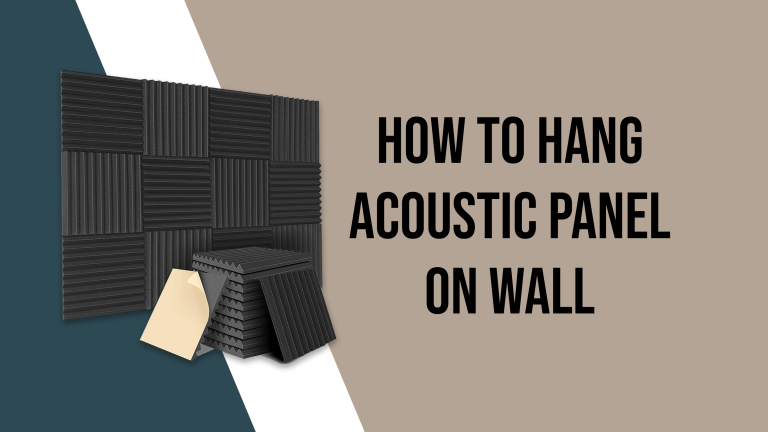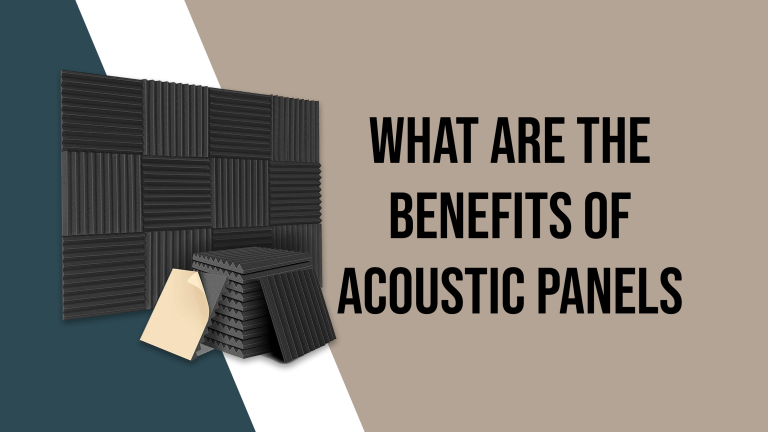How to Choose Acoustic Wall Panels
Acoustic wall panels are effective for sound absorption. You can paint them too.
In this article, we will see how to choose acoustic wall panels.
You may want to buy an acoustic panel for your office or home theater. So, there are some main factors you must consider before buying panels.
You can even make your own acoustic panel and hang on wall. And we will discuss them.
How to Choose Acoustic Wall Panels
To choose the best acoustic wall panel you must consider shape, NRC (noise reduction coefficient) rating and thickness. Its thickness should be 4 inches. NRC rating should be near to 1. It should be more than 0.75 which means the panels will absorb 75% of noise. Size and shape of room can also be a major factor.
Let’s discuss these factors in detail.
Factors to be considered while selecting acoustic panels
When you are deciding to buy acoustic panels you must consider 5 key features:
- Height and Width
- Thickness
- Pattern of Surface
- NRC Rating
Height and Width
The width and height of the panels varies. There are many smaller options like 1 by 1 ft square just like the DEKIRU Acoustic Panels. And others in large options from 2ft to 4ft such as ATS Acoustic Panels.
You can choose a panel of your desired height and width according to your room size and shape.
To cover the room area you may select a 2 ft to 4ft panel for sound absorption. These are suitable. But if you’re thinking about buying 1ft square panel, you can go for it. They are also flexible.

Thickness
The thickness of acoustic panels matters the most. Acoustic panels come with different shapes, thickness and sizes.
You must consider its size and thickness before buying an acoustic wall panel. Their thickness varies from 1 inch to 4 inches.
The panels with 4 inches thickness are much better than the panel with 1 or 2 inches.
You can select the panel according to your desired thickness. I already explained which one is better.
Pattern of Surface
You can choose the pattern of the acoustic panel surface freely.
Most of the panels come with a 3D surface. Wedged surface panels and pyramid surface panels are the most common. You can select any of them.
Pyramids are two inches thick. These are sound absorbing and sound proofing.
NRC Rating
NRC is noise reduction coefficient rating. The rating varies from 0 to 1.
If the rating of NRC is 1 it means they are highly sound absorbers. It is easy to record any music or if you want to work in loneliness. It will absorb 100% of noise.
If the rating of NRC is 0.75 it means they are good sound absorbers. It is easy to record any music or if you want to work in loneliness. It will absorb 75% of noise. Another 25% of noise will enter the room.
If the rating of NRC is 0.5 it means they are normal sound absorbers. You can record the music or if you want to work in loneliness. It will absorb 50% of noise. Another 50% of noise will enter the room.
If the rating of NRC is 0.25 it means they are less sound absorber. You may face difficulty recording any music or if you want to work in loneliness. It will absorb only 25% of noise. Another 75% of noise will enter the room; this is not recommended.
Now you can choose any of them. It’s up to you what you want.
Room Shape & Size
The efficiency of your acoustic panels is significantly influenced by the room’s size and shape.
To make placement more difficult, sloped ceilings or light fixtures can be tricky to get around if you’re installing ceiling panels.
The placement of acoustic panels may be limited by furniture or wall art you use in your house or office.
Placing acoustic panels in a “typical” square or rectangle room is a pretty simple process. Basically anywhere you can fit them, you should put some in the front, back, and sides. Your objective should be to cover every wall evenly, with at least three panels on each wall but the one with the screen.
In one of the corners, if you have a subwoofer, place a bass trap.
Things tend to grow a little messier in rooms that are significantly longer, have high ceilings, or are open concept. The surfaces opposite the speakers will obviously need to be cleaned, but there will also be some spots that you can’t really get to.
In situations like this, you’ll need to make the best use of the available space by addressing it, perhaps with ceiling panels.
However, you should consider the fact that sound will reflect off of any flat objects in the space, and you don’t want that to happen.
Therefore, even if the design of the space prevents you from placing a panel directly across from the speaker, starting by placing panels on level surfaces will still be helpful.
Put panels in the “proper” places, across from speakers, do the best you can, then add some more and more if necessary to improve the sound.
Do Larger Acoustic Panels Absorb More Sound?
The number of cells in an acoustic foam panel increases with thickness, improving sound absorption. While thicker acoustic panels also absorb lower frequencies, thinner panels are better at absorbing high frequencies.
If you want to avoid low frequency sound then use thick panels (4 Inches).
If you are looking for a panel which can absorb high frequency sound then you must choose a thin panel. (2 Inches).
Available Wall Space
The number of panels you can hang will be severely constrained by the quantity of wall space available. In a way, this is advantageous because there will be less walls for sound to reflect off of.
However, it’s terrible news if you can’t use a panel since there is a wall-mounted image. You are limited in your capacity to acoustically treat the room in the appropriate places because the image is still a flat surface that will reflect sound.
What are Acoustic Panels?
Acoustic panels absorb mid- and high-frequency sounds. Acoustic panels are great for soundproofing a studio or home.
The panel’s surface can be flat or sculpted, and it is available in a range of sizes.
Because flat surface panels are flat, sound will be absorbed by the foam’s thickness. The amount of sound absorption increases with panel thickness.
Foam panels with sculpted elements that help with sound absorption are known as sculpted panels. These sculptures could be egg crates, pyramids, or ridges.
Acoustic panels are an efficient way to soundproof any area in your house, business, or studio because they are simple to install.
How do I choose a soundproof panel?
If you want to buy quality soundproofing panels, you must choose the panel which has 4 inch thickness.
Its NRC rating should be high.
And the recommended shape is pyramid.
Are thicker acoustic panels better?
Thicker acoustic panels are best if you want to avoid high frequency waves. And thin panels are best if you want to avoid low frequency waves.
Related Articles
How Do Acoustic Wall Panels Work
Can You Paint Acoustic Wall Panel
How To Make An Acoustic Wall Panel
What Are The Benefits of Acoustic Panels








